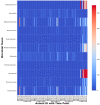Microbiome and Metabolome Variation as Indicator of Social Stress in Female Prairie Voles
- PMID: 36675193
- PMCID: PMC9861106
- DOI: 10.3390/ijms24021677
Microbiome and Metabolome Variation as Indicator of Social Stress in Female Prairie Voles
Abstract
Social isolation is detrimental to the health of social mammals inducing neurochemical and hormonal changes related to depression and anxiety, as well as impairments of cardiovascular and immune functioning. Likewise, perceptions of loneliness are increasingly recognized as detrimental to human psychological well-being, cognitive functioning, and physical health. Few studies, however, have examined the impact of social isolation on the intestinal microbiome and metabolome. To better understand the impact of social isolation on these systems, intestinal microbiota, and the systemic impact via the gut-brain axis, we employed prairie voles. Physiological stress on female prairie voles (n = 22) either with a same-sex sibling (n = 11) or in isolation (n = 11) for four weeks demonstrated behavioral indicators of increased anxiety and depression in isolated voles (p ≤ 0.01). Bacterial DNA from fecal and colon samples, collected at five time points (T0-4), were sequenced for all nine hypervariable regions of the 16S rRNA gene. Microbiome analyses revealed several differences in gut communities of paired and isolated voles with greater differences at T4. Notably, several taxa associated with host health including Anaerostipes and Lactobacillaceae were more prevalent in paired voles, whereas several taxa associated with known pathogens (e.g., Staphylococcaceae and Enterococcus) or disease were elevated in isolated animals. Similarly, metabolome analyses suggested isolated voles, when compared to paired animals, exhibited differences in metabolites associated with diabetes and colitis. These findings further contribute to our understanding of the harmful effects of social isolation, which cause perturbations in the gut microbiome and serum metabolites.
Keywords: colitis; gut microbiome; gut–brain axis; prairie voles; social isolation; type two diabetes.
Conflict of interest statement
The authors declare no conflict of interest.
Figures





References
MeSH terms
Substances
Grants and funding
LinkOut - more resources
Full Text Sources

